Cha Siu Bao – Steamed BBQ Pork Bun 叉燒包
Warning: Parameter 2 to wp_hide_post_Public::query_posts_join() expected to be a reference, value given in /home/yirese5/public_html/wp-includes/class-wp-hook.php on line 287
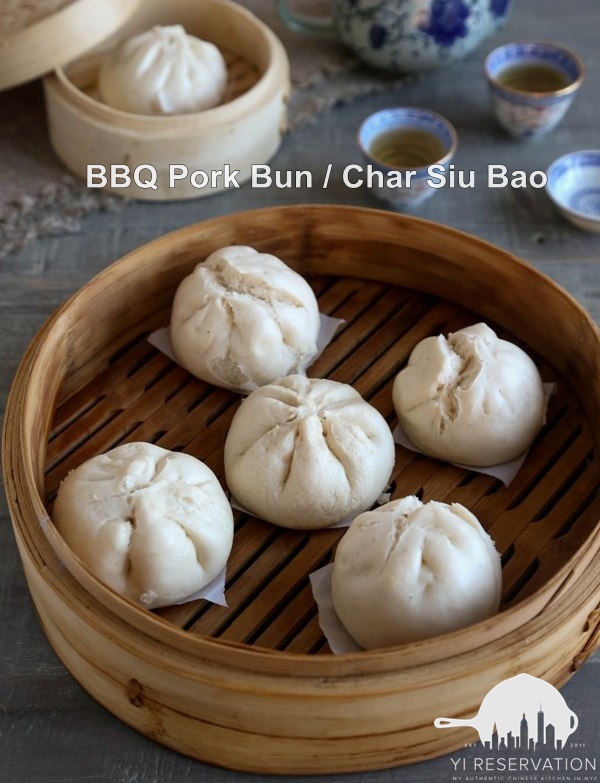
This is Part III of the Steamed Bun Series. Here are the other posts in this series:
Part I: Mantou (Chinese Steamed Bun) 饅頭
Part II: Chinese Steamed Pork Meat Bun 包子
Part IV: Steamed Piggy Buns
Steamed bun or simply Bao in Chinese, has been one of the hottest (pun intended) snack/appetizer I’ve been serving up this holiday season. In celebrating the upcoming holidays and the New Year as well as to fulfill my promise on sharing your favorite dumpling/bao recipe from NYC dumpling festival ’15 (btw, it’s an awesome event that you should all check out next year), I am very excited to share the joy of this very delicious Cantonese style Cha Siu Bao recipe. BBQ Pork Bun recipe.
Depending on where you see it, Cha Siu Bao is aka Char Siu Bao or Steamed BBQ Pork Bun or Cha Siew Bao or 叉燒包) is one of the most popular items if not THE most popular Dim Sum dish around the world. The combination of rich and savory cha siu filling and fluffy and pillowy sweet dough makes a great snack/breakfast/dessert item! With holiday season going full force, these buns are also perfect as finger food.

As a side note, you might also have seen a baked version of Roast Pork Bun which has a similar taste but made with this milk bread dough. I’ll share a recipe later if there is a level of interest.
The Dough and Filling
Now, for you avid home cooks who already perfected the traditional steamed pork buns, you’ll notice that compared to traditional pork bun recipe, this recipe has:
- Higher sugar content in the dough
- Use of cake flour and start dough
These differences result in a much sweeter and significantly lighter, softer, puffier, and almost cake-like steamed bun.

As for the BBQ pork (char siu) filling, I encourage you to make your own char siu following this easy char siu recipe. It’s easy to make and a lot of the time tastes better than the store bought roast pork. If you want to make the filling really authentic, you’ll need use fatty cut of char siu. That’ll make your buns extra juicy.
One more thing to point out is the appearance. If you looked at the images carefully, you would notice certain buns with that signature “smiling-cracks” you always see from the store bought version. I have included some notes in the recipe explaining how to create these cracks but the ones without cracks taste just as good.
It’s not an easy dish to make but with some practice and patience, you can create some seriously delicious and fluffy buns like the ones you get from your favorite Dim Sum place.
Before you jump onto this step-by-step recipe, I’d encourage you to check out the basic steamed bun (mantou) recipe, traditional steamed pork bun (baozi) recipe, and the baozi video tutorial if you have not done so. Those tutorials will give you a general idea of steamed bun making process and make making these Char Siu Bao a lot less intimidating.

Steamed BBQ Bun
Yield: 12
Prep Time: 6 hours
Cook Time: 10 minutes
Total Time: 6 hours 10 minutes
Ingredients:
Starter Dough
- 200g Cake flour
- 115g water/milk
- 1tbsp sugar
- 1tsp active dry yeast
Sweet Dough
- 315g Starter Dough (see above)
- 100g cake flour
- 80g sugar
- 20g water
- 10g butter
- 1/2tsp baking powder*
- 1/2tsp Ammonia Bicarbonate*
BBQ Pork Filling
- 100g roast pork (char siu)
- 125g water
- 25g sugar
- 10g corn starch
- 1tbsp hoisin sauce
- 1/2tbsp oyster sauce
- 1tsp cooking wine
- Salt to taste, about 3g
Directions:
 In a cooking pot, combine the rest of the filling ingredients to make a sauce and mix until all ingredients are resolved. Turn on the stove and bring the mixture to simmer. Mix with a spoon while the sauce thickens. Turn off the heat when it turns paste-looking. Cover and chill in the fridge for at least 2 hours before using.
In a cooking pot, combine the rest of the filling ingredients to make a sauce and mix until all ingredients are resolved. Turn on the stove and bring the mixture to simmer. Mix with a spoon while the sauce thickens. Turn off the heat when it turns paste-looking. Cover and chill in the fridge for at least 2 hours before using.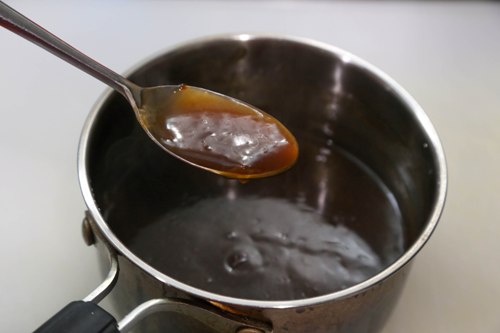 When ready to assemble the buns, combine the chilled sauce with the chopped roast pork and mix well.
When ready to assemble the buns, combine the chilled sauce with the chopped roast pork and mix well.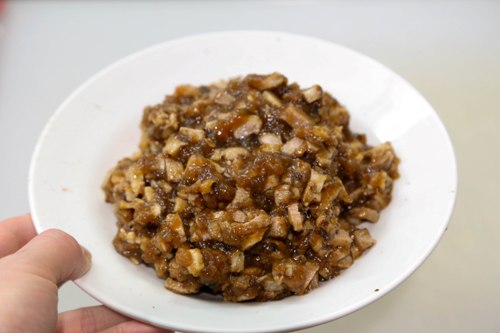 The starter dough needs to be made at least 4 hours in advance and you can also prepare it the night before. To make the starter dough, mix all the starter dough ingredients either by hand or by a mixer until a slightly wet dough is formed.
The starter dough needs to be made at least 4 hours in advance and you can also prepare it the night before. To make the starter dough, mix all the starter dough ingredients either by hand or by a mixer until a slightly wet dough is formed. 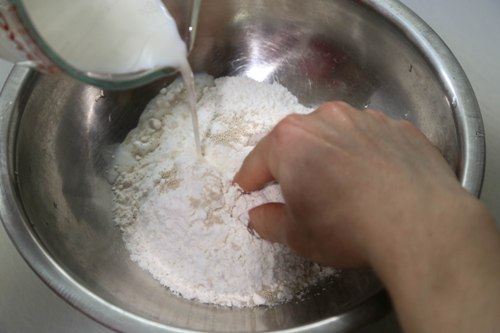 Cover the dough with a plastic wrap and let it rise for 4-6 hours or leave in the fridge over night. The dough should at least double in size. If storing it in the fridge, bring the dough back to room temperature before making the sweet dough.
Cover the dough with a plastic wrap and let it rise for 4-6 hours or leave in the fridge over night. The dough should at least double in size. If storing it in the fridge, bring the dough back to room temperature before making the sweet dough. To make the sweet dough, combine the starter dough with 80g of sugar in a stand mixer.
To make the sweet dough, combine the starter dough with 80g of sugar in a stand mixer.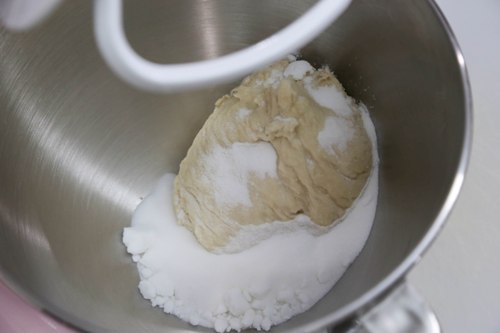 Knead the dough until the sugar is fully dissolved. You should notice that the dough is wetter and stickier. Alternatively you can also knead by hands.
Knead the dough until the sugar is fully dissolved. You should notice that the dough is wetter and stickier. Alternatively you can also knead by hands.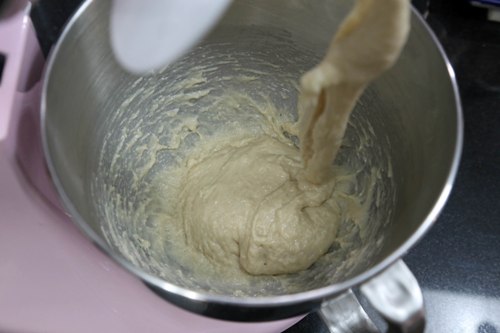 Combine the cake flour, baking powder, ammonium in a bowl and sift to remove all the crumbs.
Combine the cake flour, baking powder, ammonium in a bowl and sift to remove all the crumbs.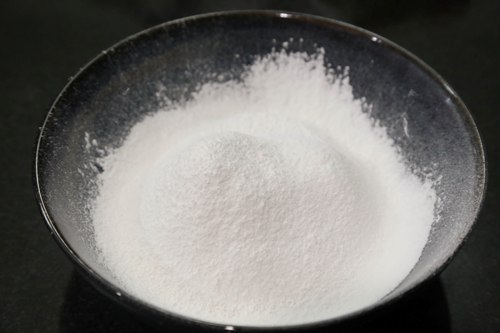 Add sifted flour mixture and water to the dough in batches. Knead the dough to incorporate the dry and wet ingredients.
Add sifted flour mixture and water to the dough in batches. Knead the dough to incorporate the dry and wet ingredients. 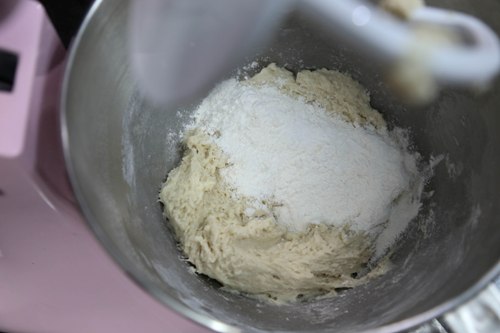 When the dough forms a ball ball, add butter and let it knead for another 5 minutes or so.
When the dough forms a ball ball, add butter and let it knead for another 5 minutes or so.  Once the dough is done, cover and let it rest for 20 minutes.
Once the dough is done, cover and let it rest for 20 minutes.  Watch this video if you are not familiar with the bao making process. To start, on a floured work station, roll the dough into a long log.
Watch this video if you are not familiar with the bao making process. To start, on a floured work station, roll the dough into a long log.  Cut the dough into 12 equal disks.
Cut the dough into 12 equal disks.  Lightly cover each dough disk with flour and flatten with your palm. Roll the disk into a dough wrapper.
Lightly cover each dough disk with flour and flatten with your palm. Roll the disk into a dough wrapper. 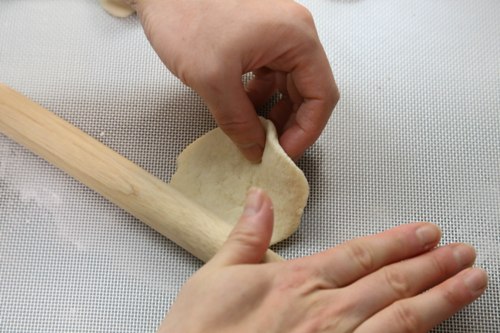 Pack 1 to 1.5 tsp of chilled pork filling in the center of the wrapper.
Pack 1 to 1.5 tsp of chilled pork filling in the center of the wrapper.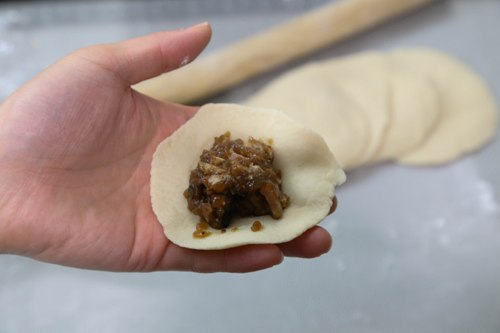 Fold the wrapper around the filling to fully enclose the bun.**
Fold the wrapper around the filling to fully enclose the bun.**  Let the buns rest for 30 minutes and steam over high heat for 10 minutes. Once the heat is off, leave the lid on for additional 2 minutes before removing the lid and serving. These buns need to be served hot!
Let the buns rest for 30 minutes and steam over high heat for 10 minutes. Once the heat is off, leave the lid on for additional 2 minutes before removing the lid and serving. These buns need to be served hot!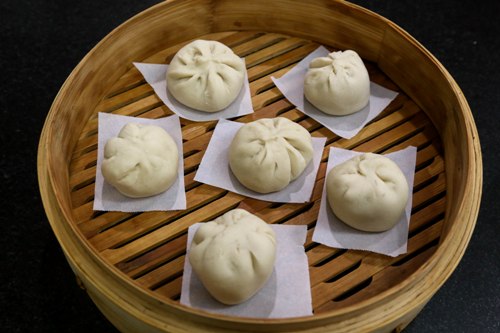
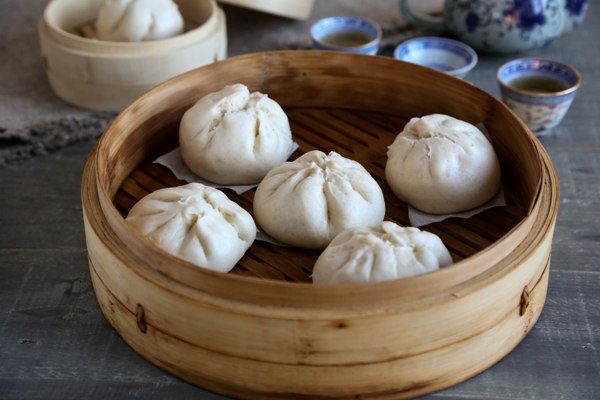
Warning: Use of undefined constant rand - assumed 'rand' (this will throw an Error in a future version of PHP) in /home/yirese5/public_html/wp-content/themes/yireservation/single.php on line 72
Warning: Parameter 2 to wp_hide_post_Public::query_posts_join() expected to be a reference, value given in /home/yirese5/public_html/wp-includes/class-wp-hook.php on line 287



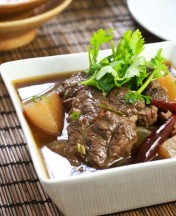
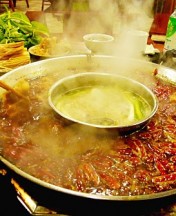
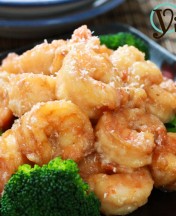
Hi, Thank you for posting these recipes, I love steamed buns. Just would like to ask if it would be possible in your recipes to use ounces or milliliters when using liquids and tsp/tbsp/cups/ etc. for solids? It is more common and it is kind of burdensome to measure the containers weight first and then add the water to reach the desired grams.
hello Jules, thanks for checking out the recipe. I’ll work on converting the units. One the reasons I used weight for solids is I found tsp/tbsp/cups not quite as accurate. Please check back soon for the updated recipe.
Hi Mr. Yi, Resent to correct my previous question. Do you have to use BAKING SODA or Ammonia Bicarbonate? If I don’t use any of them will that change the texture or the taste of the bao?
Thanks
Hi Mr. Chef Yi, I resent to correct my previos question. I meant to say. Do you have to use BAKING SODA or Ammonia Bicarbonate for this recipe. If I don’t use any of them will that change the texture or the taste of the bao?
Hi, Do you have to use baking powder or Ammonia Bicarbonate? If I dont use any of them will that change the texture or the taste of the bao?
Thanks
hello Ella, the use of baking soda is to reduce the sourness in case the dough was raised for too long and it’s not 100% necessary and it does not alter the taste. Thanks.
Dear Mr Yi,
Thank you for sharing the recipe. I’ve tried to make the wet dough according to the measurements in your recipe. I chose milk instead of water. I found that the dough is ‘hard’, and didn’t look at all like in your photo. I left it to rise in a sunny place but after 6hrs, dough didn’t rise at all. Another hour later, I found that the smell is already off. Sadly, I had to discard it. I really want to try the recipe ‘all the way through’, please advise if I’ve done something not right. Thanks.
hi Koon, sorry for not getting back to you late. If the dough didn’t raise at all, it tells me that something is wrong with the yeast activity. Do you know when the yeast was purchased? Or perhaps the milk was too hot and killed the yeast? Hope that provides some clues to your issue.
OMG, I made these today and they are delicious! I’ve made steamed buns from other recipes and also from the premix you get from Asian groceries.. not great. But the fluffiness and subtle but complex taste from this pao recipe is just heavenly.
I have a burning question and hope you will reply. Is there a reason why you made a different bun recipe here and not use the one you did with the pork bun recipe? Why use cake flour here instead of all-purpose in your other bun recipes?
Thanks so much for a great recipe.
Hi there, thanks for checking out my recipe and glad that the buns came out tasty. To answer your question, the dough for char siu bao is traditionally different from the generic steam bun dough. This kind of dough is from Cantonese cuisine where the texture of the dough is lighter and fluffier. The way I like to think is the Cantonese style dough has the texture of cake while the generic dough feels like bread.
Thanks for sharing!
I just tried the dough recipe and i liked it. My children said “yummy, more delicious than the buns we bought in the store” .
Thanks for the feedback. Glad to hear that the kids approved 🙂
Hi, these BBQ pork buns look perfect. Btw, where can we buy the Ammonia Bicarbonate for I want to make my buns with smiling cracks too, though I know it is not easy to make but I’ll try. I am hoping you will also post a juicy pork asado filling recipe Thank you for sharing the recipe..
Hi There, thanks for checking out the recipe. I got my ammonia bicarbonate from a chinese grocery store here in NYC. Where are you located? Also please confirm the kind of pork asado filing you were referring to? Thanks.
Hi, thank you for the recipe
Hi Jennie, thanks for visiting. Hope you get to make these fluffy buns!
Yi, what is cake flour?
Hi there, cake flour is a type of wheat flour that contains very low level of gluten and commonly used for making light and fluffy cakes. You should be able to find it in most grocery stores worldwide. Hope this helps.
看看!
Looks great Yi! I had a question about the starter dough – is it 115g for water/milk? And what is the difference between using milk vs. water for the starter dough? Thanks!
Hi Thomas, thanks for checking out the bbq pork bun recipe. It is 115g of water/milk. I just updated in the recipe. Thank you! The difference between using milk and water is that milk gives the bun better flavor and makes the buns white. If milk is not part of your diet, you can totally use water. Regards, Yi
These BBQ pork buns look just like the ones in restaurants! Nicely done, Yi! I wish I could have a dozen now! YUM!
Thank you. Yeah these buns are pretty addictive.
My favourite snack ever! I always prefer this over burgers when I was a child.
Love your recipe!
Thanks Raymund. This is also one of the snacks I don’t mind eating everyday!
Hi Yi, I am very happy to see the recipe that you promise , so kindly of you. I can’ t wait to try it. The buns look perfect, i hope to do samething similar but it is not easy. Thank you so much and have my best season greetings and a happy 2016.
hello Anna, happy new year to you too! Please let me know how the buns come out if you get to make them 🙂
Looks good but they are so inexpensive and readily available at the local branch of Asian Markets that I have little incentive to make them. They have baked and steamed and related items like red bean, curry beef and chicken in baked bao and flaky crust.. They have one I really like but I don’t know what it is called in Chinese.It is a steamed bao with a ground pork and vegetable filling that reminds me of wonton filling. Thanks for your blog; I really enjoy it.
Thanks for stopping by Jeff. The steamed meat bun is a traditional pork bun aka baozi
wow they look just like those you find in the dimsum restaurants! Well done, Yi!
Thanks Angie.
This is my fave! I buy the baked version by the dozens to keep on hand for snacks! So happy to see this! Can’t wait to try!
Thanks Abbe. Please let me know how you like the recipe if you get to try it.